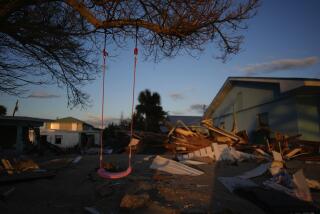Healthcare Feeling the Strain
- Share via
BATON ROUGE, La. — Authorities along the Gulf Coast faced the near-collapse of the public health system Tuesday, with water supplies sporadic, electricity shut off, hospitals closing and the threat of more injuries and infectious diseases in the aftermath of Hurricane Katrina.
Officials also warned of other problems, including encounters with snakes, alligators and other wildlife displaced by the flooding, and the need to minister to the mental health needs of survivors who have lost almost all their worldly possessions.
The biggest problem may be that modern medicine requires electricity and that little was available Tuesday -- and the crisis could persist for the foreseeable future.
At least 10 hospitals in New Orleans were using generator-supplied electricity. Several had closed.
State health authorities have been transporting critically ill patients out of the city by boat, helicopter and bus, said Dr. Jimmy Guidry, Louisiana’s health officer.
About 2,500 patients who were not initially evacuated because doing so might have killed them must now be moved. About 500 high-risk patients -- some breathing with ventilators -- also must be evacuated.
Tulane University Medical Center said Tuesday its emergency generator was in danger of being inundated by rising floodwaters, and as many as 1,000 of its remaining patients were transferred to the Superdome, which was housing at least 10,000 tourists and newly homeless.
Four people, three of them hospital patients, died Monday night at the stadium, Guidry said.
“Right now our concern is with the living,” he said.
“We know people are fragile. We’re doing everything we can, but we’re going to lose some people.”
Charity Hospital and Baptist Hospital in the heart of New Orleans were heavily damaged and had been closed, perhaps permanently. The New Orleans Times-Picayune newspaper reported that medical workers at Charity had to manually ventilate patients after backup generators failed.
Many storm casualties are being treated at West Jefferson Medical Center in the suburb of Marrero. Hospital spokeswoman Jennifer Steele said the hospital was operating “beyond capacity” and that they hoped to set up several MASH units on the lawn overnight.
The Navy has provided diesel fuel for the hospital’s generators, and some of the shuttered hospitals have sent medical supplies.
Beyond the immediate problems are a host of impending problems, said Dr. Jeffrey Goldhagen, director of the Duval County Health Department in Florida and a veteran of hurricane planning.
In a city of 500,000 like New Orleans, there are probably 5,000 people who require kidney dialysis twice a week, he said.
“Where will they get it? Where will 2-month-olds get their immunizations? Where will people get their pharmaceuticals for the next three to six months?”
Doctors at University of Alabama Medical Center in Birmingham were told late Tuesday to expect infants from Jefferson Parish, La., neonatal intensive care units that had been closed because of flooding.
New Orleans’ primary water main broke during the storm, and reservoirs have been contaminated by overflowing seawater and sewage. Officials estimate that it will be weeks before the water supply is restored and probably about as long for electricity to return.
Some officials are worried that contaminated water could spread diseases, such as cholera, dysentery and other gastrointestinal infections, as floodwaters mix with waste and the decaying bodies of animals.
After flying over the region, Bob Odom, Louisiana state commissioner of Agriculture and Forestry, said he had not seen any animal corpses but that as many as 150,000 cattle lived in areas affected by the storm.
“If we’ve got any animals that are dead, how are we going to find them? How do you destroy an animal that has water on it?” he said.
“It’s a lot of water, y’all.”
But other officials said the fear of disease after flooding is generally overblown.
As long as fresh water is provided, such outbreaks are unlikely, Guidry said. Officials said they could not remember even one outbreak occurring after a natural disaster.
Federal troops and members of the National Guard are trucking in bottled water, ice and food -- such as military MREs, or Meals Ready to Eat -- and will continue to as long as necessary, officials said.
On Tuesday, the Centers for Disease Control sent five truckloads of supplies to Louisiana, including cots, blankets, medicines, towels and surgical masks.
The agency also has sent in 38 physicians, spokesman Tom Skinner said.
Doctors have begun to see a second wave of injuries: those sustained during the cleanup effort, including people who fell off roofs, came in contact with downed power lines or were cut by chain saws.
Carbon monoxide poisoning caused two deaths and 12 hospitalizations in New Orleans after generators were used in poorly ventilated buildings, Skinner said.
The Associated Press reported two near-electrocutions by downed power lines.
Floodwaters also have poured over the countryside, affecting a variety of wildlife. Poisonous snakes, fire ants, even alligators have been forced from their habitat and into close proximity with humans, with potentially fatal consequences.
Pools left behind as the water recedes will provide breeding grounds for mosquitoes, carriers of West Nile virus and other infectious diseases.
Authorities cautioned people doing cleanup to wear long-sleeved shirts and mosquito repellent.
They said spraying for mosquitoes would begin as soon as possible.
Psychological and emotional issues brought about by the disaster will have to be handled later, Goldhagen said.
“Families who have lost everything will have to deal with a great deal of stress,” he said. “Post-traumatic stress disorder will be a serious problem.”
He added that there was probably no system in place to deal with it.
Barry reported from Baton Rouge and Maugh from Los Angeles. Times staff writer Robert Lee Hotz in New York contributed to this report.
More to Read
Sign up for Essential California
The most important California stories and recommendations in your inbox every morning.
You may occasionally receive promotional content from the Los Angeles Times.










